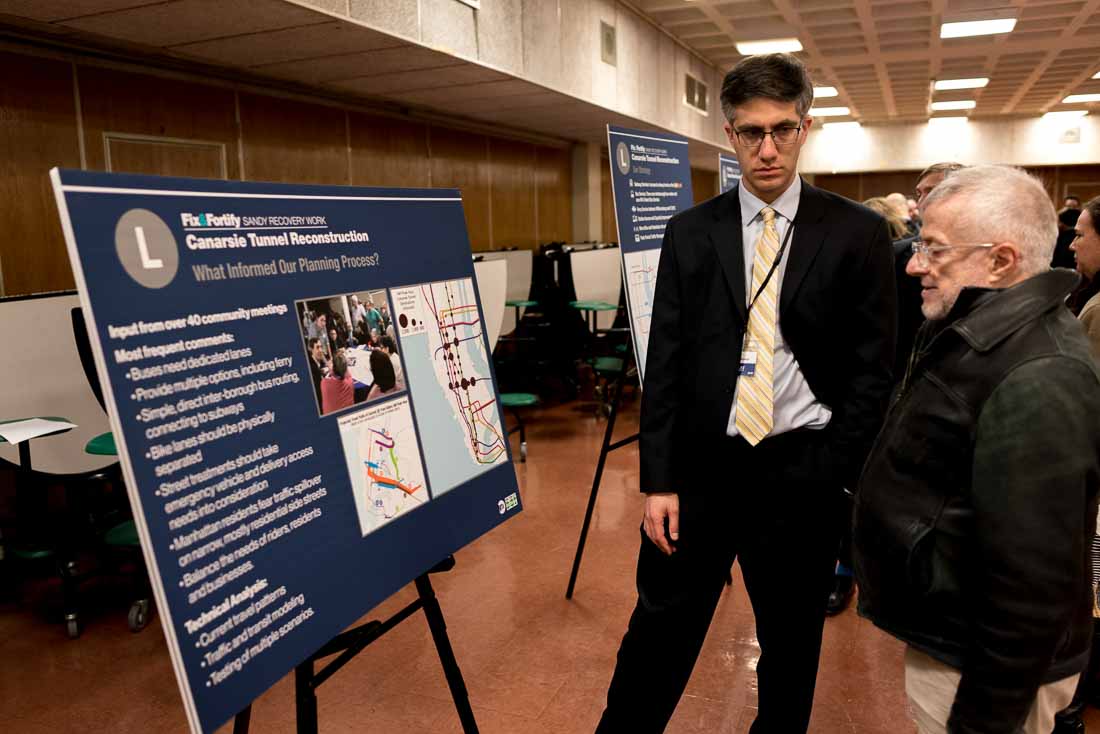MTA, DOT Launch Open House Meetings to Gather Feedback on L Train Shutdown


EAST WILLIAMSBURG – Last night, the MTA and DOT held the first of four open house meetings about the L train closure. At Grand Street’s Progress High School, North Brooklyn residents and concerned citizens of all stripes came out to see what answers the agencies could give regarding the April 2019 shutdown.
Of course, those attendees arriving by L train to the Grand Street stop had to push their way onto Rockaway-bound trains coming across from Manhattan packed to the gills with commuters. It was a blunt reminder of the stakes of the entire repair project and the 225,000 riders that will soon need to find another way across the East River.
In the high school’s cafeteria, posterboards printed up with maps, infographics and text stood around the room like displays at a science fair. Each station was staffed by eager, solicitous MTA and DOT employees, ready to explain new bus routes, service changes and preparations for what they are referring to as the Canarsie Tunnel repairs—perhaps in an effort to steer away from the decidedly more catastrophic and all-encompassing phrase “L Train Shutdown.”

Andy Byford, the newly appointed President of New York City Transit, was in attendance “as a sign of the importance” of the L train repair plans, he said. “The plan is well advanced, and we think it’s a good plan,” said Byford. “But it’s not yet set in stone.” The transit president promised to listen to community feedback in order to fine-tune the plan in the coming months.
Byford also stressed that the time during the shutdown wouldn’t be used solely for repair, but also to make improvements at affected stations, something he called “a bit of payback to the people for their patience.”
For all the information carefully printed and available for review at the open house, decidedly little was new to those who have been following the proceedings. But for many members of the public, it was one of the first opportunities to truly engage with MTA and DOT’s proposed plans to mitigate the effects of the 15-month closure.
“I do believe the MTA does their best,” said Sam Manock, a nearby resident, as she looked over the placards that illustrated mitigation strategies. “And the work’s gotta get done.”
“I’m trying to get a sense of what my options are,” she said. Despite having never used the NYC Ferry, Manock said the proposed direct route from Williamsburg to Manhattan seemed like her best bet to replace a daily work commute into the city via the L train.
Manock has lived near the Montrose L stop for about two years, and while she could walk down to the Broadway G or Lorimer JMZ, she’s “down to try new transit.” Of course, with a lease coming up for renewal in the summer, she’s wondering if it’s worth sticking around—as are many of her neighbors. “I’m prepared to be open-minded,” she said.
Some of those in the fight, however, were guarded in their response. “I’m glad after six months of stonewalling we finally get an update,” said Philip Leff, a volunteer and activist with the North Brooklyn coalition of Transportation Alternatives. “Now that we have the plans, the debate can take on a new dimension.”
While MTA officials touted the 40 plus meetings they say they’ve had with community groups, Leff scoffed. “There were months of radio silence,” he said, “from June to December.”
Though the materials showed plans to prioritize bus traffic on Grand Street—along with protected bike lanes—Leff feels the plans don’t go far enough, especially considering the “peak hours” qualifications added to the plans. “Peak hours are all hours,” he said, citing a recent midnight L train ride he found just as crowded as during the day. “This is a center for art and culture all hours of the day and night—replacement service needs to reflect that.”
With more open house meetings in the next few weeks (the next Brooklyn meeting is in Williamsburg on February 8) more riders will have a chance to learn about the plans, and the two agencies promise they will be looking for feedback in the future. Leaving the meeting, though, it was back to reality down in the subway, as L trains kept rattling by in rapid succession, each one full to capacity.
Update: The story has been amended to clarify the dual responsibility of both the MTA and the DOT in planning a response to the upcoming shutdown




